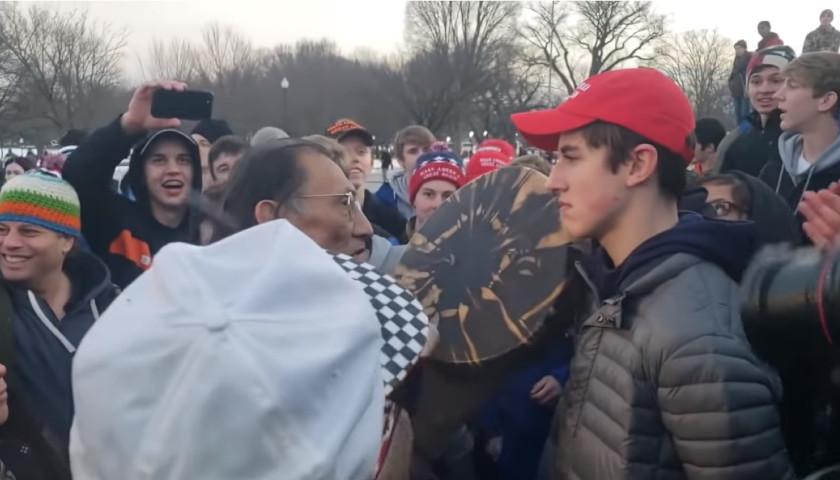by Deion A. Kathawa
A Jimmy Carter-appointed federal district court judge in Kentucky on Friday dismissed Nicholas Sandmann’s defamation lawsuit against the Washington Post. The Covington Catholic High School student’s two other suits against CNN and NBC remain active, however.
Recall that Sandmann became Public Enemy No. 1 after video surfaced of him perpetrating a heinous crime on the steps of the Lincoln Memorial the day after the 2019 March for Life: standing while white and MAGA-hatted. Even worse, he appeared to smile as Nathan Phillips, a Native American adult who approached Sandmann and his friends, loudly banged a drum in Sandmann’s face.
Sandmann, still a minor, was quickly smeared as a disgusting racist by thousands of adult, leftist pundits (shamefully abetted by many so-called conservatives), politicians, and activists. The Twitter mob said Sandmann had a “punchable face” and was a “prime candidate for wood chipping.” He became the embodiment of “white male privilege,” a scapegoat for all the world’s wickedness. He was even deemed complicit in Christ’s crucifixion! Ultimately, he was abandoned to the mob by his own bishop, as well as by a neighboring bishop who just couldn’t resist the urge to woke-signal.
Applying a Kentucky defamation statute, the court held that 33 statements from seven Post articles and three tweets—which Sandmann alleged were defamatory and entitled him to $250 million in damages—were all protected as opinion under the First Amendment. “Few principles of law are as well-established as the rule that statements of opinion are not actionable in libel actions,” Judge William O. Bertelsman wrote in his ruling.
In assessing the relevant defamation precedents, Bertelsman focused primarily on the first of the seven articles (the other six and the three tweets contained mostly recycled statements from the first article) and determined that nine of the 33 statements were not even “about” Sandmann in particular and thus were not actionable; another seven statements (some of which overlapped with the previous set) could not “form the basis for a defamation claim” because they were mere opinions, not factual statements “capable of being proved objectively correct.”
Most importantly, the court explained that “[i]n determining whether a writing is libelous per se under Kentucky law, courts must stay within the four corners of the written communication.” Which means the “words must be given their ordinary, natural meaning as defined by the average lay person,” and the “face of the writing must be stripped of all innuendoes [sic] and explanations” that could “enlarge or add to the sense or effect of the words charged to be libelous, or impute to them a meaning not warranted by the words themselves.”
Bertelsman also analyzed the allegedly libelous publications in their entirety to “determine if [their] gist or sting [are] defamatory”—in other words, if they would “tend to expose Sandmann to public hatred, ridicule, contempt or disgrace, or to induce an evil opinion of him in the minds of right-thinking people.” For a statement to be defamatory, it cannot be an opinion; it must be about someone in particular; and it has to in itself—without reference to any “extrinsic evidence of context or circumstances [or consequences]”—be injurious to its object. None of the 33 statements, in Bertelsman’s determination, met this threshold, even as many people then and now hold “an evil opinion” of the “smirking” Sandmann.
Unfortunately, that conclusion follows more or less inescapably from Bertelsman’s straightforward application of Supreme Court and Sixth Circuit precedents to the facts of the case.
That Sandmann couldn’t convince the court to find that even one of the nearly three-dozen statements constituted defamation indicates deep rot at the core of this area of First Amendment jurisprudence. Especially so when the district court declined to reach a critical question in defamation law, namely, whether Sandmann was either a “public figure” or a “limited-purpose public figure.” Indeed, it is difficult to see how such an analysis could result in a finding that Sandmann—who did nothing to seek the public-square spotlight and the firestorm that later enveloped him—was anything other than a purely private figure, a classification which would have given his lawsuit a much higher chance of success.
Recently, Justice Clarence Thomas, concurring in the denial of certiorari in McKee v. Cosby—a case that asked the court “to review [the petitioner’s] classification as a limited-purpose public figure,” a classification rooted in the landmark defamation case, New York Times Co. v. Sullivan (1964)—put it best when he wrote, “New York Times and the Court’s decisions extending it were policy-driven decisions masquerading as constitutional law.”
What the New York Times decision and its progeny, including this case, get wrong is that free speech, for the Founding generation, generated a correlative duty to use it responsibly for the pursuit of truth, and its primary regulators were to be state legislatures, not courts. The Founders were not free-speech libertarians (even as the Supreme Court increasingly, and worryingly, has embraced such a relativistic vision of speech), and a world in which the press can, even incidentally, sic a ravenous, self-righteous mob on a teen and plaster racist next to his face forever and suffer no real consequences is not truly a free society.
The Pennsylvania Supreme Court described why in 1788:
Libeling is a great crime. . . . With respect to the heart of the libeller, it is darker and base than that of the assassin, or than his who commits a midnight arson. It is true, that I may never discover the wretch who has burned my house, or set fire to my barn; but these losses are easily repaired, and bring with them no portion of ignominy or reproach. But the attacks of the libeller admit not of this consolation: the injuries which are done to character and reputation seldom can be cured, and the most innocent man may, in a moment, be deprived of his good name, upon which, perhaps, he depends for all the prosperity, and all the happiness of his life.
No less an authority than Dante concurs; he placed liars deeper in hell than the violent because lies “offend against the rational part of the human being, which is nobler and more in need of protection even than the body.”
Sandmann plans to appeal, and he should, even though the Sixth Circuit likely would be forced to affirm Bertelsman’s decision thanks to decades of too-lenient defamation precedent that now robs private citizens of our right to our good names.
The Supreme Court should take this opportunity to reign in its runaway defamation jurisprudence, restore (at least to a degree and in this one area) the original understanding of the free speech clause, and tame our public discourse—which today more resembles the Wild West than a public square of a constitutional republic ordered to truth.
Free speech exists to secure human flourishing and the common good of the nation. We should take it back from those who have weaponized it to create a culture of fear as they push an anti-American agenda.
– – –
Deion A. Kathawa is a Mt. Vernon Fellow of the Center for American Greatness, a J.D. candidate at Notre Dame Law School, and a graduate of the University of Michigan-Ann Arbor.
Photo “Covington Catholic Incident” by officer Sweetchuck.





